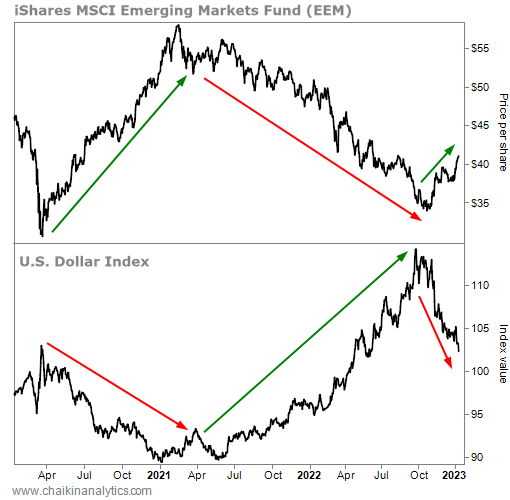The U.S. dollar is the king of currency…
It leads the global economy. And all other currencies depend on what’s happening with it.
It’s easy to see this relationship in international transactions. Since the dollar is the world’s reserve currency, that’s how many of these deals are settled.
Take the Taste America grocery store in England, for example…
The store pays to import goods like cereal, coffee, and tea in U.S. dollars. That’s how it pays shipping costs as well. All those costs were up in 2022 due to inflation and higher oil prices.
Plus, back in October, the dollar was hitting multiyear highs. So the store was losing about 20% on the exchange rate between the dollar and the British pound.
Put simply, a strong dollar weakens the worldwide economy. The reason is simple…
A strong dollar generally comes with higher interest rates here in the U.S. And of course, the Federal Reserve has been hiking rates over the past year. Since higher rates make borrowing money more expensive, growth slows both domestically and internationally.
But in recent months, the dollar has retreated. Its value is down nearly 11% from its September peak. And as I’ll explain today, that pullback is boosting one group of stocks…
The group of stocks I’m talking about is emerging markets.
Emerging markets are in the process of becoming developed economies like the U.S. or the United Kingdom, but they’re not quite there yet. Because of that, companies in these countries can experience rapid growth. And that can lead to greater returns for investors.
We’ll focus on the iShares MSCI Emerging Markets Fund (EEM) today…
As its name implies, this exchange-traded fund (“ETF”) tracks a basket of more than 1,200 emerging market stocks. Roughly 32% of the portfolio is in China. And India (14%), Taiwan (14%), and South Korea (11%) each make up more than 10% of the ETF as well.
The chart below compares the performance of the dollar and the iShares MSCI Emerging Markets Fund over the past three years. Take a look…

This chart might look a little complex at first glance. But one thing is clear…
An inverse relationship exists between the dollar and EEM.
As the dollar’s value goes up, the ETF’s value goes down – and vice versa.
Start with what happened from the worst days of the COVID-19 pandemic through early 2021. The dollar’s value dropped nearly 14%. And EEM soared 71% over that span.
Then, from early 2021 through this past September, the dollar’s value surged about 28%. And sure enough, EEM plunged around 33% over that period.
Now, notice what started happening in September…
The dollar has lost nearly 11% of its value since it peaked on September 27. Over the same span, EEM is up about 16%. That’s a 27-percentage-point outperformance.
You might be wondering why the dollar’s value started dropping even though the Fed is still raising interest rates. And frankly, it’s a bit convoluted. But it boils down to this point…
Bond prices and yields are inversely correlated.
As the Fed raised rates, yields on bonds surged as well. That caused bond prices to plunge.
But around September, investors decided that bonds were attractively priced. And they started buying again. That drove down rates. And in turn, the dollar’s value fell as well.
In the end, a weaker dollar is a tailwind for EEM (and emerging markets overall).
And at least for now, we can expect the recent trend to continue…
The king of global currency is weakening. And emerging market stocks are thriving.
Good investing,
Pete Carmasino